This is the first post in our new Creator Series: Expert Insights —where I team up with some seriously smart experts and creators to spill the tea on all things marketing and beyond.
First up is the fabulous Leanne Wong, an SEO coach who’s going to share some of her best secrets for getting your site to the top of those Google search results in 2024. Leanne actually gave me so much juicy info, so I’m breaking it down in this handy table of contents for ya. 👇👇👇
Trust me, you don’t want to miss her tips—they’re pure gold. Let’s get into it!
What’s New with SEO in 2024
Can you share any surprising trends or shifts that businesses need to be aware of this year and how those are impacting SEO? (Algorithm updates, AI, etc.)
1. Google’s March core update
Yes! I think the first major shift in 2024 was the March 2024 core update that tackled unhelpful, low quality content and AI generated content spam. It was a major update since there had been a lot of AI generated content spam cluttering the search results, which was why Google had to come in with the update and clean it up. A LOT of it, in fact.
This update was surprising because it was the first one that directly tackled the surge of low quality AI generated content showing up on the search results. Previously core updates regarding content have been about Google improving its ability to understand natural language, search queries and better rank results. E.g, Expertise (EEAT) signals update (2022) Passage Indexing update (2020), BERT update (2019).
The March update, however, was different. Google addressed the issue of AI generated content spam by removing them from the search results. Also, the speed and scale of Google’s implementation of this update was significant. Google reduced 40% of low quality content on the search results and those negatively impacted saw catastrophic drops in traffic within days. Source, Google Blog – The Keyword
Websites negatively impacted saw -75 to 90% drops in traffic, and some analyses reported 800+ websites completely deindexed (removed from the search results) . Source, Search Engine Journal
While blogging sites were most impacted by the update, we have seen stable rankings for our coaching client sites, some even positively impacted since the update. My understanding is that when the blogging sites and their long-form content were dropped from the search results, other websites rose up to fill the gap left behind, filling its place in rankings. Google has also said that the Helpful Content Update (HCU) and March core update aimed to reward ‘hidden gems’ with truly valuable and unique perspectives.
So websites with high quality, unique content that Google wanted to show more on the search results have benefited from the update. I have more data in my helpful content case study here.
What businesses need to be aware of in 2024
Generative AI is widely accessible and Google does not prohibit the use of AI to create content. The issue is low quality, low value content. Businesses creating content (whether by AI or hand) need to know that the search engine is looking for original, valuable and helpful content. The standard for content quality is now higher. That means creating content that is informative and accurate. Provides truly beneficial information to a human being and offers original, first-person experiences.

2. Google’s AI Overviews
The second surprising trend is the AI Overviews (previously, Search Generative Experience) that Google launched in May 2024 for US searches. AI Overviews are quick answers that automatically generate summaries for complex queries.
It was surprising because AI Overviews had a relatively short-lived rollout. There was mixed reception for it, users found that the summaries provided inaccurate and even dangerous answers. Google acknowledged this issue and dialed it back. Source, Google Blog – The Keyword
Currently, AI overviews appear for only 15% of queries, though at one time it appeared on 84% of queries. Source, Search Engine Land
Another thing that is positively surprising is Google’s stance on prioritizing “sending valuable traffic to publishers and creators”. So there will be web links included in the AI Overviews as Google pulls information from different websites to answer the query. This could potentially mean more traffic to websites if Google uses your site content in the AI Overview. Source, Google Blog – The Keyword.
What businesses need to be aware of
The AI Overviews in Google Search is still experimental, undergoing fine-tuning and not yet ready. But it is a step towards a better search result. It is possible we will see AI-generated answers at the top of our search results in the near future. Hopefully good ones 🙂
Businesses should do SEO for their website and online visibility. Having an optimized site will help Google find and understand your content.
This would only be advantageous for you when Google Search advances, and there is a Generative AI component on the search result – websites that are optimized will surely stand a better chance to benefit. Think ranking at the top, and benefitting from new SERP features. Think featured snippets, rich results, and SERP features that enhance how your website is shown on the search engine. And the increased traffic and visibility that you can gain.

3. Google content warehouse API leak
The third surprising development in SEO this year has got to be the Internal documentation leak. The leaked code gave us a glimpse of what attributes are actually used in Google’s ranking algorithm (the hard evidence). Here are the original analyses from Spark Toro and iPull Rank.
This was a surprise because the leaked documentation revealed several things that were contrary to what the Google representatives (i.e John Mueller, Gary Illyes) have preached for years. I’ll list a few:
Domain Authority
- For years, Googlers have said there is no such thing as Domain Authority used in its system. Now, we know that denial is false. 👀🤯
- In the Google code leak, there is an attribute called ‘SiteAuthority’ that is used in rankings.

Source, Gary Illynes, X
Sandbox
- For years, Googlers have said that the age of a website did not matter and fresh websites were not placed in a ‘sandbox’ that demoted their ability to rank.

- Since 2004, the SEO community found that new websites took a longer time to rank on Google. John Mueller and Gary Illynes kept denying this. We now know this denial is false.
- In the Google code leak, there is an attribute called ‘hostAge’ that is used to sandbox fresh websites and prevent new websites from ranking at the top of search results.
Keyword Research Techniques
What are the most effective keyword research techniques in 2024 you are seeing with your business or client’s businesses? (long-tail, short-tail, keyword variations, etc.
1. Keyword Mapping
The most effective keyword research technique that continues to work till today is after finding keyword ideas, to assign keywords to pages.
Here’s how that looks like in practice:

I do this keyword mapping exercise for my own website and get my 1:1 clients to implement it within 2 months of coaching. Just doing this step alone can bring so much clarity to your keyword research and SEO strategy.
We know:
- Exactly what keywords we want to rank for
- And which page is assigned to rank for that keyword
This way, there is no uncertainty about what keywords to target or how to rank for those target keywords. We know exactly what keywords to pursue and which pages to create or optimize to rank for key phrases.
The benefit of proper keyword mapping is that you can rank for many related keywords with one content asset.
Rank for one main keyword, rank for dozens, if not hundreds of keyword variations
I’ll share an example of one of my blog posts.

This is a Google search console screenshot for one of my blog posts.
See how this one blog post ranks for many keyword variations – keyword synonym, variation, related keyword.
Also, notice how each keyword variant brings in clicks to the same one article. Combined, these keyword variations bring in over 1,600 clicks to my one article alone.
The methodology here was to assign the main keyword to this one blog post, and create the best content to answer that keyword. Then, let Google do the rest by ranking the article for its keyword variants.
2. Local Keywords
The next most effective keyword research technique that works well till today — if you serve customers in a geographical area is to target Location based keywords. Search queries with a local intent (e.g, [service/product] near me, [service/product] in [city/state].
Location based keywords are driven with transactional intent and continue to have significant search volume. If the user can find your business in the local pack or Google Maps, you can attract qualified users to your business.
While Google algorithm updates have always affected the organic results, Local Search has remained unaffected for decades. If you have a Google business listing, strive to target location keywords and rank at the top of the local pack.

Best Content to Rank in Search
What kinds of content are you seeing with the best performance ie. listicles, long-form, image-heavy etc.? (Or does it depend on your niche?)
The content that performs best are the ones that provide the best answer to the keyword query. The content formats can vary.
We have seen image-heavy blog posts like yours about 29 pastel color palettes examples that rank for over 2,900 keywords and drive over 13,000 organic traffic monthly.

The article was image-heavy, with no more than 800 words, I believe. But the content quality, as you know, answers the keyword query well.
In the content, you have pastel color palette examples that were visually appealing, and well put together by your expertise. A person searching for “pastel color palette” would be well served landing on this article.
Naturally, Google rewarded the content with top 3 positions for your target keywords. And I’m happy to see those rankings have continued in their top positions year after year!
Another article that does quite well is your blog post that featured 7 brand kit examples. It ranks in position #1 for “brand kit examples”, above more authoritative sites like Piktochart and Canva!

That article is a long-form content piece, with more than 1,000 words. It ranks #1 for its main keyword and 124 related keywords because it is a good, helpful answer for someone searching for the keyword, “brand kit examples” and its keyword variations.
The article provides more information such as what is a brand kit, what is included in one, with step-by-step instructions on how to create your own brand identity kit. In addition, the user can find a curated list of 7 brand kit examples to inspire them.
This is another example of a well performing article that maintained first page rankings year after year, against the backdrop of Google’s algorithm updates 🙂
New Technology That Impacts SEO
Are there any new tools or technologies that have made a significant impact on technical SEO this year?
1. Google search console’s core web vitals report
Yeah! The first advancement is more granular reporting and integration of core web vitals in Google search console.
We can see the core web vital usage data for each URL group, and the INP (Interactive Next Paint) metric. INP is supposedly more precise than the previous First Input Delay metric.

2. IndexNow feature in Ahrefs’ site audit tool
Another useful, new development in Ahrefs’ site audit tool is the IndexNow feature.
Ahrefs automatically selects pages they recommend you submit for indexing. Such as new pages published on your website, and pages with new content changes.
For example, I recently published a new page about my course, and Ahrefs’ Site Audit tool noticed it was a new page and recommended I submit the new page for indexing.
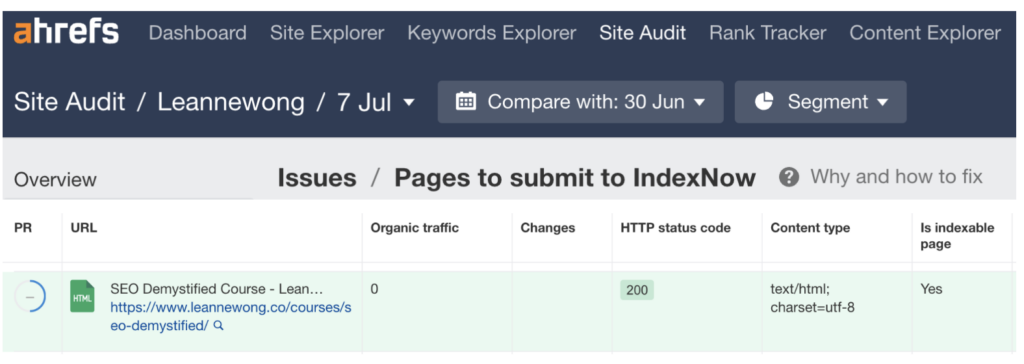
3. Semrush site audit progress report
Another site audit tool that I’ve found to be very useful this year is the Progress report from Semrush’s site audit tool.
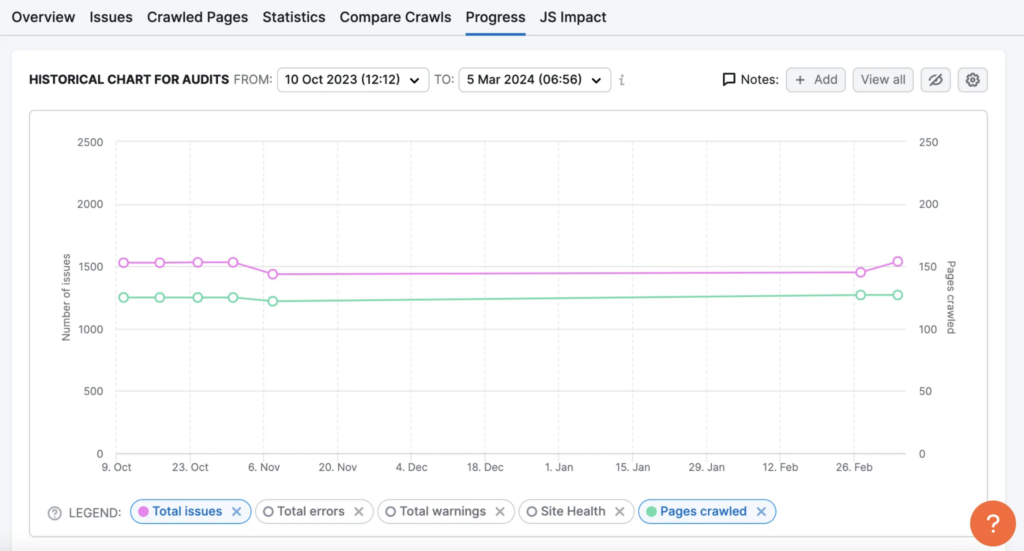
You can monitor the progress of your website’s health over time and check if there are more or less errors appearing on your website. You can choose specific metrics and date periods to compare in the tool.
And follow the issues, errors and warnings on your website that have been fixed or if new issues have appeared over time.
How to Earn Authoritative Backlinks
What are some practical strategies for small businesses to earn authoritative backlinks to improve their domain authority? (Do you recommend cold outreach, directory listings, or other strategies?)
Over the years, I have found relationship links to be the most organic and quite successful at building authority. This way, you foster a genuine connection with other people first and in the process earn quality links/referrals.
1. Content Collaborations
For example, collaborations. Co-created resources where parties come together on a piece of resource like a course, ebook, workbook. Both parties can publish the valuable resource on their websites, and link to each other. It is a natural way to build relationships and at the same time, earn quality links.
2. Broken Link Building
Another effective way to earn authoritative backlinks is through broken link building. This is about finding broken links on websites within your niche.
Broken links could be links to outdated content or websites that no longer exist. If you find a broken link on an external website, you can create a similar (but improved) piece of content on your site and then reach out to the website owner, suggesting your content as a replacement for the broken link. Since nobody wants broken or outdated content on their site, the website owner is inclined to replace that broken link with an active one (where you come in).

What about Local SEO?
For businesses with a local focus, what are the most impactful local SEO tactics they should be implementing to drive local traffic?
The most important thing for local businesses would have to be ranking in the top 3 positions in the Local Pack. So tactics about optimizing your Google business profile would be most effective.
Ensure your GBP listing is accurate, complete and furnished with as much useful information as possible. Make use of all the relevant fields GBP allows and fill those in.
For example, just adding in your opening hours can make your listing more visible. Google calls out your opening hours very clearly for people to see.

If people come across your listing on search and don’t know if you’re open or not, they may think you’re closed, they may not come by your business, they may not call.
So see how one of the listings here says “open” and the other doesn’t have that opening hour information? That can make a huge difference to how people engage with your business.
Another example is adding your service areas. There is a section in your GBP listing to add your physical address and up to 20 areas you serve — within 2 hours of driving time.
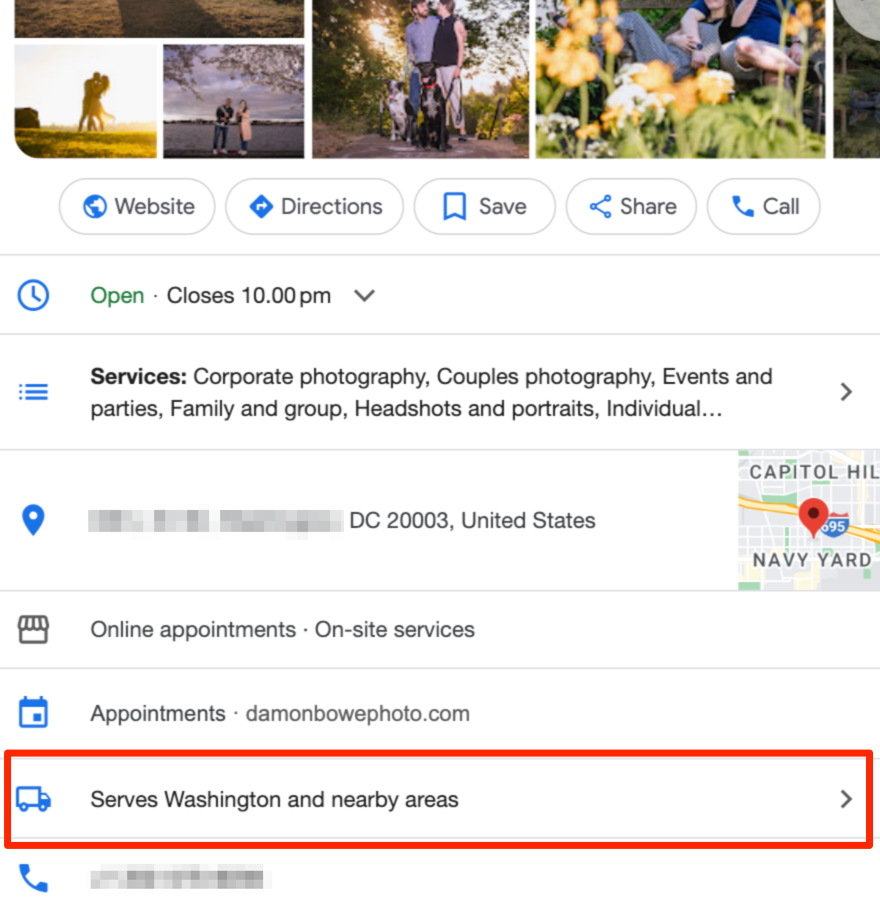
This can help your GBP listing show up for more local searchers within a larger geographical proximity.
One more GBP profile optimization that you shouldn’t leave out is your Services information.
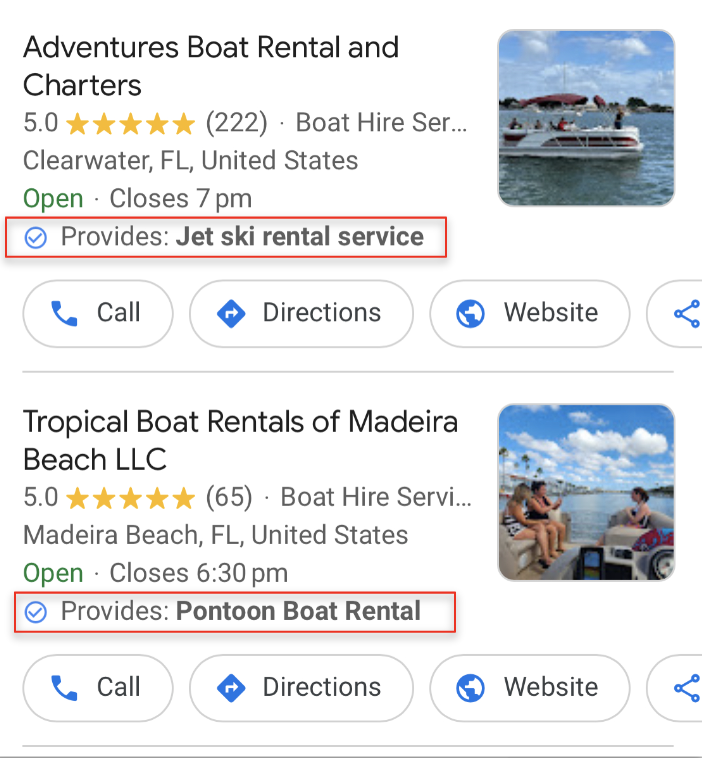
As you can see, Google displays that Services information with a ‘justification’ tick mark with bolded texts to show users. This can make your GBP listing more attractive and get users to engage with your business.
Lastly, get more Google reviews. This increases the prominence of your GBP listing and is a strong factor to help it rank higher in the local pack.
How should you measure success of SEO?
What are the key metrics and tools you like to use to measure the success of SEO efforts? (Can you give some examples of how you interpret these metrics to make decisions?)
1. First-page Rankings
Ranking on the first page for valuable keywords in your niche and market is a key metric of success.
For example, if you are a fitness coach in Montreal, you want to rank for “fitness coach montreal” in the first 1-10 positions in organic results and the top 3 positions in the local pack.
Achieving these rankings can help a business a lot. Showing up at the top of Google search for your main keywords can bring in interested users, potential customers to the business.
To interpret these metrics, I’d use Google search console and a rank tracking tool to assess the current keyword ranking position, the gap from the current position to page 1 rankings, and who the search competitors are.
I’d monitor ranking position changes every week and every month to see if SEO optimizations we are doing are taking any effect in moving the website closer to page 1.
2. Content Performance
Another measure of SEO success is content performance. We can check if our content pages are engaging or converting from organic search.
This can tell you if the quality of traffic from Google is good, if your content is resonating with users searching. We can do this with GA4.
GA4 > Engagement > Landing Pages report
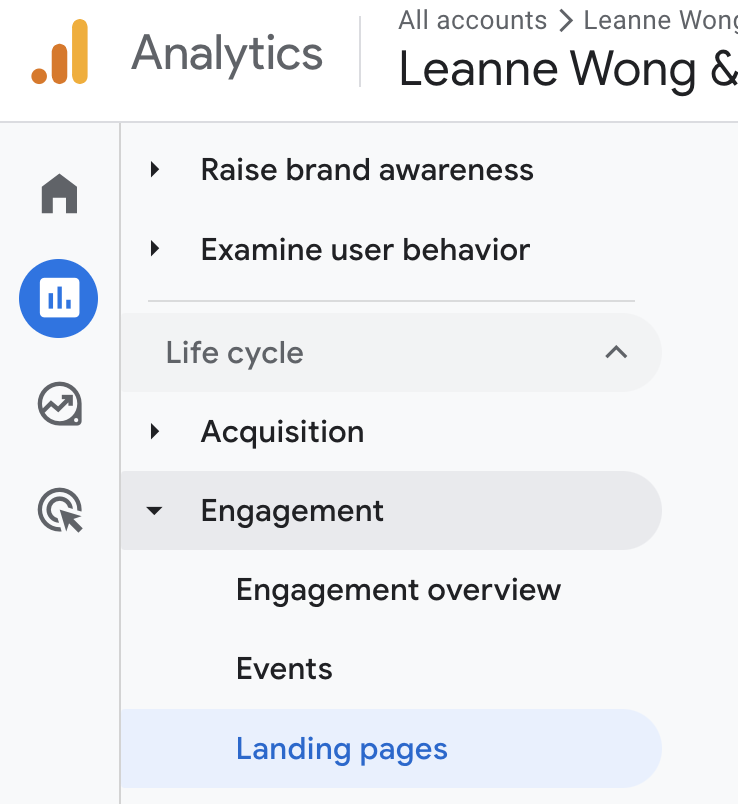
All Users > Organic Traffic

- New users: Which pages did people land on first from Organic Search. This tells you which content pages are your inbound traffic drivers
- Average engagement time per session, engagement rate: How each landing page resonates with users
- Key events: Which landing pages led to conversions
Landing Pages report
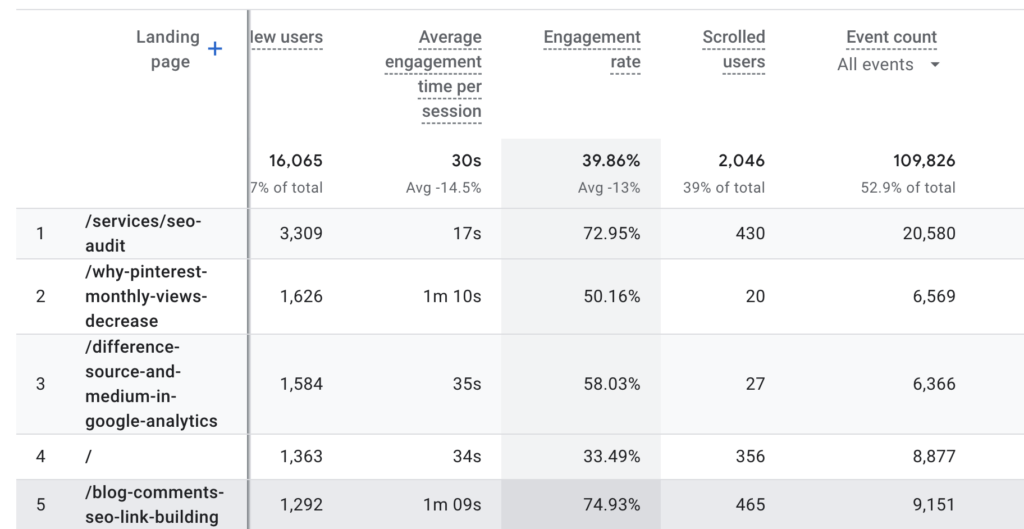
3. Organic Inquiries
Another simple way to assess SEO success is organic inquiries. For example, if you have a contact form on your website, consider adding a form field that asks “how did you find me?”
If you see form submissions come through on your website and people indicate they found you from “Google”, “by googl-ing”, “found you on google”, that is a measure of SEO success.

SEO Trends You Should Know
What upcoming SEO trends and changes should business owners prepare for to stay ahead of the competition in the next few years?
1. AI-Powered Search Engines
Business owners should be prepared for AI-powered search engines. This is the biggest change coming to Search.
Google’s experimental AI Overviews (previously search generative experience) provides users with a curated content summary directly on the search results page. Imagine a featured snippet, but interactive and more informative. We may see potentially reduced traffic to websites as a result or even more traffic, the impact is uncertain.
2. Website Optimization
We do know that websites need to be optimized. When Google’s AI Overviews become more reliable and dependable, that may become a coveted spot on the search results that websites want to rank in as well.
To compete in the AI-powered search engine, I imagine we would need an optimized, search engine friendly website too. That means these SEO optimization remain important:
- Websites that provide a good user experience. Think core web vitals and responsiveness.
- Website that is search engine friendly. Think technical SEO and site hygiene.
- Website design that is user-friendly. Content quality that is engaging. Think keywords, on-page SEO, content quality, and engagement metrics like click through rate and page retention.
The May 2024 leaked Google documents mention various click metrics like good clicks, bad clicks, and dwell time (lastLongestClicks). A user spending more time on a result (potentially indicated by dwell time) could be a positive sign.
The leak also highlights page retention – Google stores past versions of indexed pages. This could be for analyzing how users interact with a page over time. Pages that keep users engaged for longer might be seen as more relevant.
3. Authoritative Websites
- Websites that are authoritative. Think quality backlinks and online reputation. We know from the Google leak again, that a metric called ‘SiteAuthority’ is used in rankings.
All this to show that there are many SEO optimizations to do to keep a website search engine friendly and competitive on search results. And also, many of these SEO factors are not new. We’ve known them for decades, and have applied them as an SEO best practice.
To stay ahead, I think just working on the fundamentals mentioned above would keep your site in good standing.
Next, just keep up with Google’s AI developments on Search, and insights from the SEO community. There is a lot of information published on new changes and updates to get up to speed. Some trusted sources I go to to stay informed:
- Google Blog – The Keyword
- Google Search Central announcements
- Search Engine Journal, Search Engine Land
Free SEO Resources
Do you have any free resources you want to share that can help our readers?
Yeah! Here are some free resources I’d love for you to have:
📝94 point SEO Audit Checklist to fix and optimize your website for SEO like a pro. Download here
👩🏫 And if you want to just hang out and learn SEO, I teach a free 30-minutes SEO Nugget & Nudge class every month. These classes are short, relaxed and pitch-free. Check for upcoming classes here!

Leanne Wong
SEO Coach and Course Instructor
Leanne Wong is a SEO coach and course instructor. She has 8+ years of experience managing SEO projects, and loves coaching business owners how to show up for more Google searches. Check out her 1:1 SEO coaching service here.













